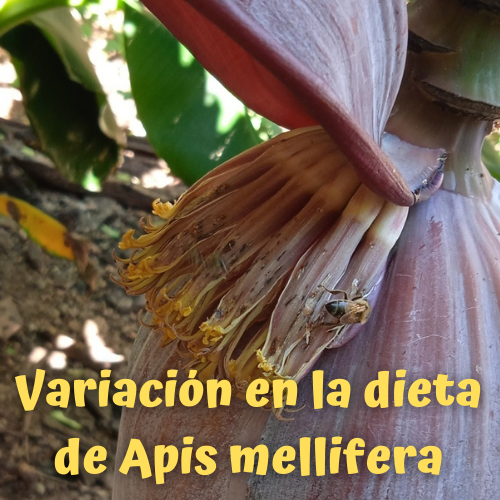
Bees are usually beings with fixed customs. Their diet and their schedules are generally predictable, it is only enough to observe them carefully and you will be able to know them; however there are times when their behaviors change and this is surprising.
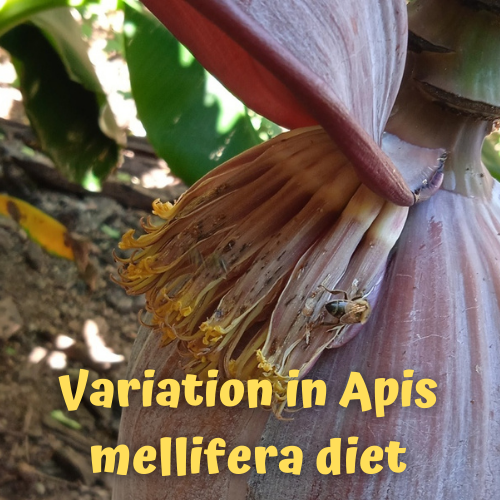

I was able to see one of these cases weeks ago on my lot, where various species of musaceae grow, but to a greater extent I have macoyas (groups) of the variety commonly known as topochos, whose scientific name is Musa paradisiaca L. , and correspond to the group Musa ABB. These plants throughout their life give an acorn, which once the fruits of the upper part grow, the tip remains, offering nature beautiful flowers, which are the delight of hummingbirds (Trochilidae) and the variety of melipona bees called pegones ( Trigona spinipes ); so it is normal to observe these species sucking their flowers
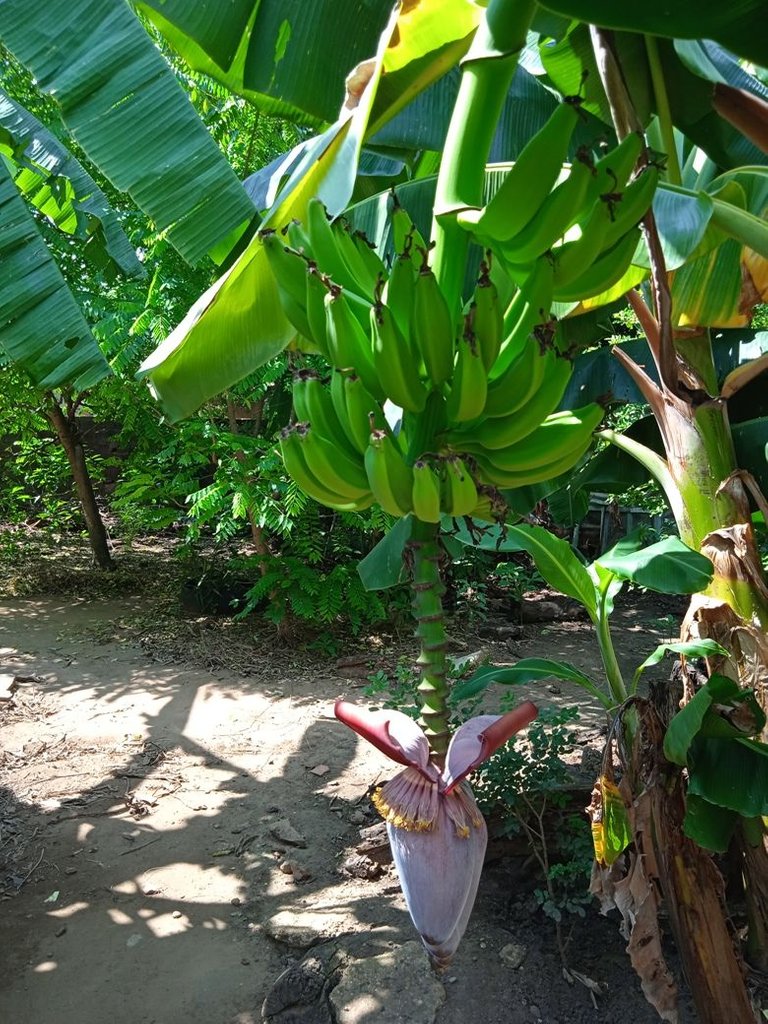
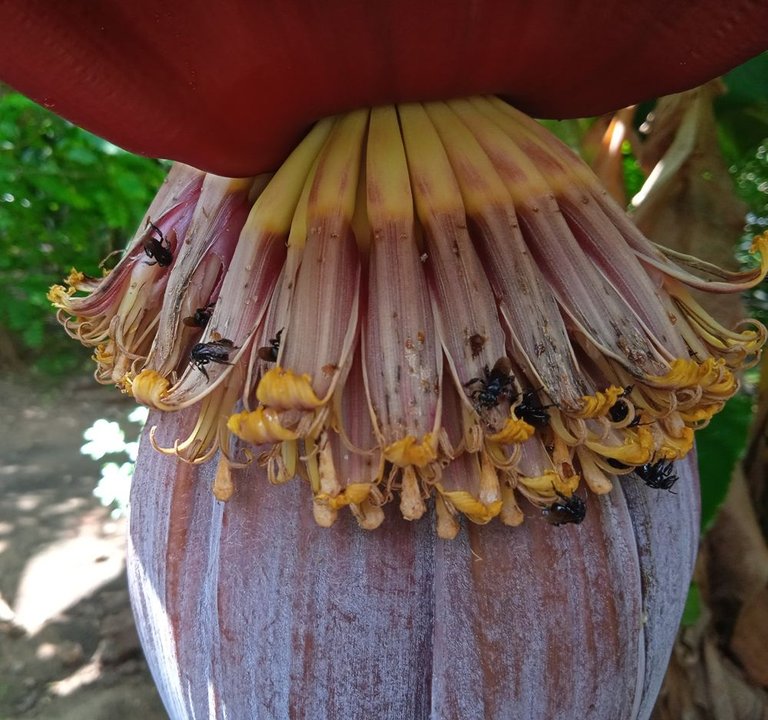
Trigona spinipes

Now, what caught my attention is that I could see a domestic or common bee, called Apis (Apis mellifera), sucking these flowers, which is extremely unusual, since they choose by citrus flowers or by those of guava (Psidium guajava), those of lemon balm (Lippa alba); semeruco or red cherries (Malpighia emarginata).

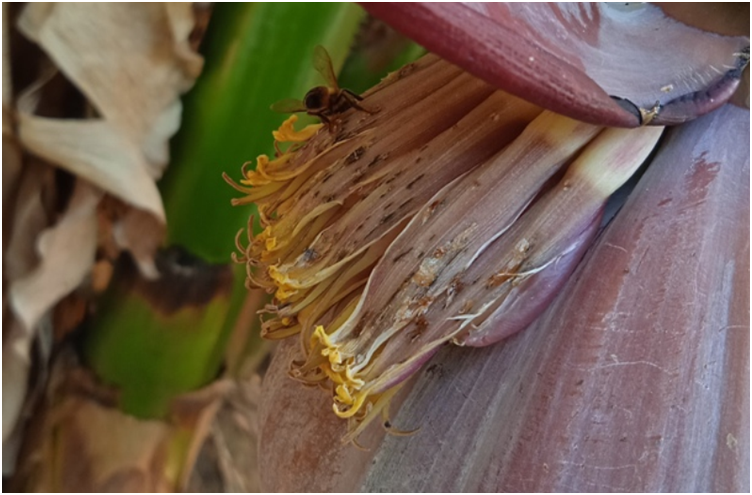
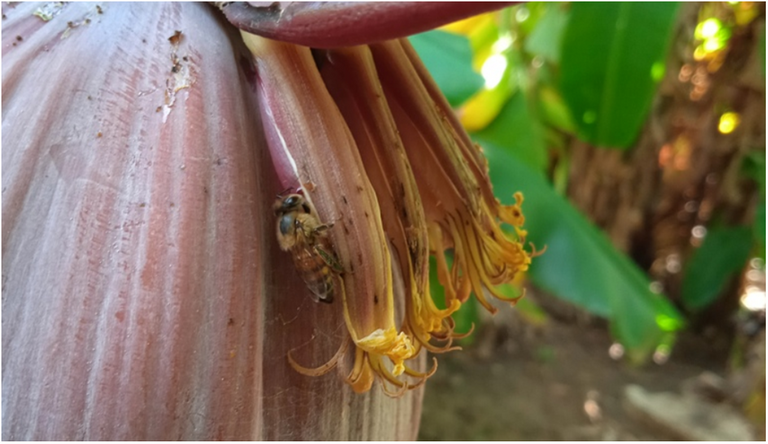
Apis mellifera

Accompanying this bee, I saw a variety of Melipona bee, morphologically similar to a wasp, and according to my experience it lacks a sting, because although I usually handle them they have never stung me. These little bees have an approximate length of 7 mm. They make a nest with tiny mud cells, on the underside of the leaves of banana plants ( Musa sapientum) and have a predilection for the flowers of that specific variety of musaceae, and rarely visit the flowers of the topochos, which also surprised me. I was researching, and I could not locate which specific species or type it corresponds to, since there are many varieties of meliponas in my country, but I do not have access to a catalog of them. I affirm that it is a melipona due to the absence of poison, but not because I see it sucking the topocho flowers; Let's remember that wasps feed on various sources, both insects (lepidoptera, bees, etc.), even flower nectar, so their diet is not the only indicator of their species.
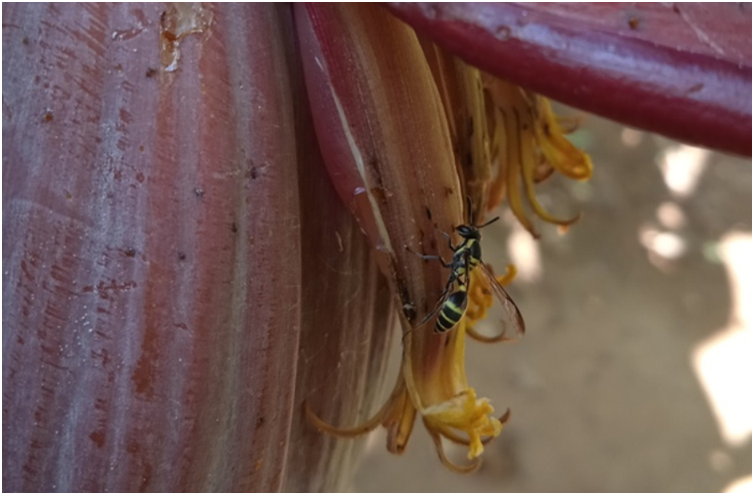
Melipona de variedad desconocida / Melipona of unknown variety

Los azúcares o hidratos de carbono: Estos macronutrienes provienen del néctar y en este caso hay tres tipos: Fructosa, glucosa y sacarosa; cada especie vegetal ofrecerá un nivel o combinación distinta de estos, o sea, los cítricos tienen cierta proporción de estos tres azúcares; mientras que la guayaba varía su fórmula, y así sucesivamente.
Los minerales, vitaminas y grasas: Los obtienen del polen que cosechan de las flores, y también varían en su composición. El néctar también cubre una parte de estos requerimientos nutricionales.
El agua: Que beben directamente de porciones de este líquido, y también lo obtienen del néctar. Por eso es importante dejar muy pequeñas raciones de agua en nuestras áreas verdes, especialmente en época de verano o sequía, que iremos renovando diariamente. Tienen que ser pequeñas para que estos insectos no se ahoguen mientras beben.
Si se presenta un desequilibrio en estos elementos, se afecta la salud de las abejas; por tal razón deduzco que las variaciones en la dieta de esta Apis mellifera y de su compañera la abejita melipona de nombre desconocido, pueden obedecer a dos causas:
Primero: Las flores de topocho les ofrece algún componente que está ausente o presenta déficit en su dieta actual.
Segunda: Debido a la temporada de sequía o verano actual, no hay muchas plantas en floración, por lo que dejan de ser selectivas y liban las flores que estén disponibles. Creo que esta última es la explicación a la variación en el comportamiento alimenticio de estos insectos.
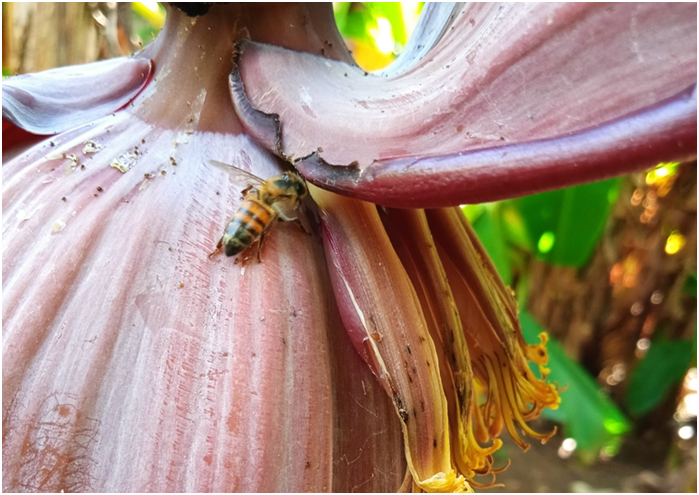
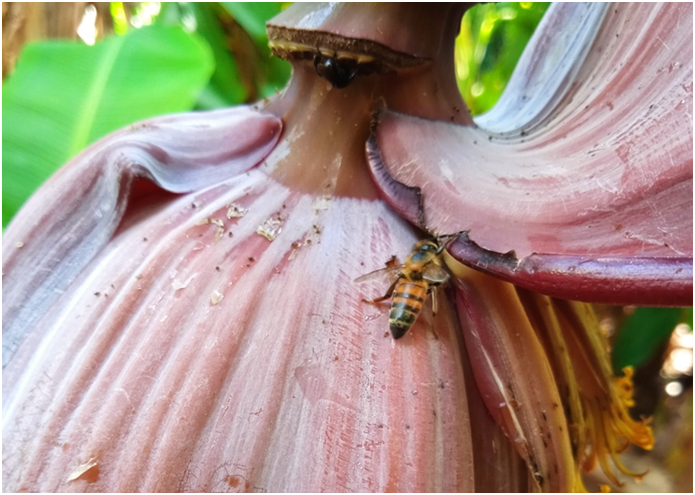
It should be noted that bees not only consume flower nectar, they also eat pollen that is stored in the honeycomb, drink water and feed on honey, the product they generate through the processing of previously collected nectar, which they do thanks to certain enzymes. The nutritional contributions they receive in their diet are the following:
- Sugars or carbohydrates: These macronutrients come from the nectar and in this case there are three types: fructose, glucose and sucrose; each plant species will offer a different level or combination of these, i.e. citrus fruits have a certain proportion of these three sugars; while guava varies its formula, and so on.
- Minerals, vitamins and fats: They get them from the pollen they harvest from flowers, and they also vary in their composition. The nectar also covers a part of these nutritional requirements.
- The water: Which they drink directly from portions of this liquid, and also obtains it from the nectar. That is why it is important to leave very small rations of water in our green areas, especially in summer or drought, which we will renew daily. They have to be small so these insects don't drown while drinking.
If there is an imbalance in these elements, the health of the bees is affected; For this reason, I deduce that the variations in the diet of this Apis mellifera and its companion, the Melipona bee with an unknown name, can be due to two causes:
- First: The topocho flowers offer them some component that is absent or deficient in their current diet.
- Second: Due to the current dry or summer season, there are not many flowering plants, so they stop being selective and take the flowers that are available. I believe that the latter is the explanation for the variation in the feeding behavior of these insects.

If you would like to learn more about different varieties of bees, here are my previous posts on the topic:

Here I end my post for today, I hope it has been pleasant for everyone, and remember that Mother Earth is kind, loving to all of us; and each and every one of her creatures play a fundamental role in ecosystems. Greetings.

Todas las fotos de este post son de mi autoría y fueron tomadas con mi teléfono Xiomi REDMI 8 A // These photos are my own, and were taken with a Xiomi REDMI 8 A phone
Los divisores son cortesía de @eve66 quien comparte bellos diseños que embellecen el maquetado de nuestras publicaciones. // The dividers used are courtesy of @eve66 who shares beautiful designs that embellish the layout of our post.
En caso de que se requiera utilizar el contenido o las imágenes de este post y de mis otras publicaciones, agradecería que se hiciera referencia a mi autoría (Fabiola Martínez) y se citara el enlace correspondiente. Gracias. // In case it is required to use the content or images of this post and of my other publications, I would appreciate if you could refer to my authorship (Fabiola Martínez) and cite the corresponding link. Thanks.


Find our community here.
DiscordIICuration Trail

Ohoh maravilloso.
Que suerte tienes de qué te haya visitado las abejas mi ciudad lamentablemente alguna de estas no han aparecido para ser la polinización de algunas plantas, entre ellas, la de plátanos.
Pero tenemos la fortuna de que los abejorros nos han estado visitando y han hecho un poco ese mismo trabajo.
Excelente investigación, me encantó.
Hola @ismaelrd04, muchas gracias por detenerte a leer y comentar mi post. Sí, afortunadamente en mi solar y en las casas circunvecinas hay árboles centenarios, por lo que existe un ecosistema propicio para ellas; además la disminución de la actividad humana debido a la pandemia, ha incrementado la visualización de especies poco comunes. En cuanto a los abejorros, ellos son realmente útiles, les encantan las flores de brusca negra, de parchita y de guayaba, de hecho, son los polinizadores naturales de las parchitas, ya que el grano de polen de esa especie vegetal es de mayor tamaño y peso, y por ende requiere un agente polinizador más robusto, y ese trabajo lo hacen los abejorros. Saludos.
Mi bella amiga @sirenahippie, había leído de tu bello y visto en fotos tu solar y plantas que allí tienes y me encanta recordar todo lo que ya has publicado, sobre todo recordar que vive en ese lugar mi querido amigo Señor Morrocoy y su familia que tantas risas y ternura me han dado, pero de verdad no sabia que conocías tanto de abejas me has sorprendido y enseñado mucho en tan breve pero suculenta publicación, las fotografías y tus líneas me han ilustrado muchísimo, fíjate que en estos días observe o mejor dicho me puse a observar a profundidad un hormiguero que tenemos en los jardines de la Urbanización y he pensado en dedicarle una publicación porque esos insectos tan trabajadores lo merecen, de verdad mi bella amiga muchas gracias por compartir todo ese conocimientos con quienes te seguimos un abrazo grandote para ti.
Hola @actioncats, muchas gracias por tu extenso y hermoso comentario. Me alegra mucho que esta información te sea útil, ya que las abejas son la piedra angular de todos los ecosistemas del planeta, de allí que sea vital conocerlas, respetarlas, amarlas, protegerlas y conservarlas, por eso es que hago este trabajo. Respecto a las hormigas, ellas también tienen su nicho ecológico, y son muy importantes para la Naturaleza, sería genial que hicieras un post de ese tema, pues de esta forma las personas pueden conocer más a estos insectos. Espero que estés bien. Un gran saludo.
Nota: El Sr. Morrocoy en estos días está hibernando, pero parte de su familia sigue activa. Cuando él salga del letargo, haré un post.
Tan bello mi Sr Morrocoy, presumo que aquellos bebés ya estan más grandes, eran mínimos cuando los presentaste.
Sí, han crecido aunque son pequeños aún. Este próximo mes o quizás en Marzo los doy en adopción, ya consiguieron una buena familia.
¡Me encanta escuchar eso!, Es una maravilla, uno es feliz cuando consigue buenos hogares para los animales.
Sí, y con una familia que tiene niños, que pueden cuidarlas.
Hiciste un gran trabajo con tu publicación, las abejas son muy importantes, sin ellas no habría mundo. Gracias por compartir con la comunidad.
Buenas tardes @nicanor-mosquera. Estaba pendiente de pasar a responder, me disculpa lo tarde. Muchas gracias por su apreciación, es valiosa para mí. Es cierto, las abejas son la piedra angular de los ecosistemas, las personas aún no comprenden la magnitud de su importancia, de allí que me guste dar a conocer sus peculiaridades, conocimiento que obtengo a través de su observación en mi solar. Saludos.
Gracias a ti por publicar en nuestra comunidad de insectos, es bueno tener publicaciones de calidad como la tuya.
We appreciate your work and your post has been manually curated on behalf of Insects Of The World Community. It will be added to the weekly curation report. Keep up the good work.
Ohhh, it is an honor, thank you very much for selecting my work. Greetings!
Hola @sirenahippie es muy interesante el tema sobre las abejas porque me parece que son insectos necesarios por todos los beneficios que dan incluyendo la rica miel. Las fotos me hicieron recordar a las matas de topocho en casa de mi abuela. Saludos 💙